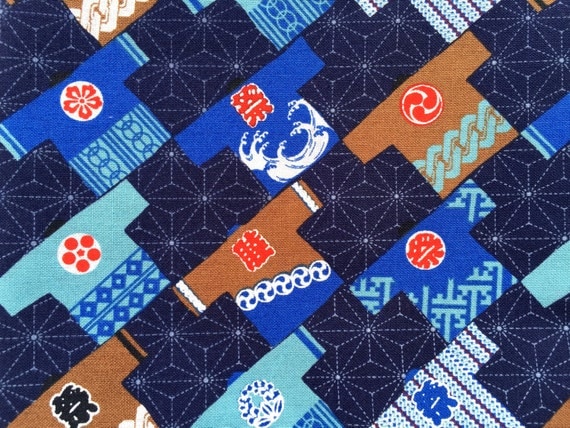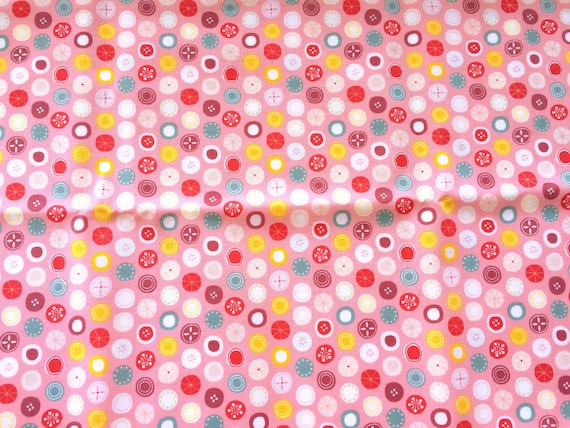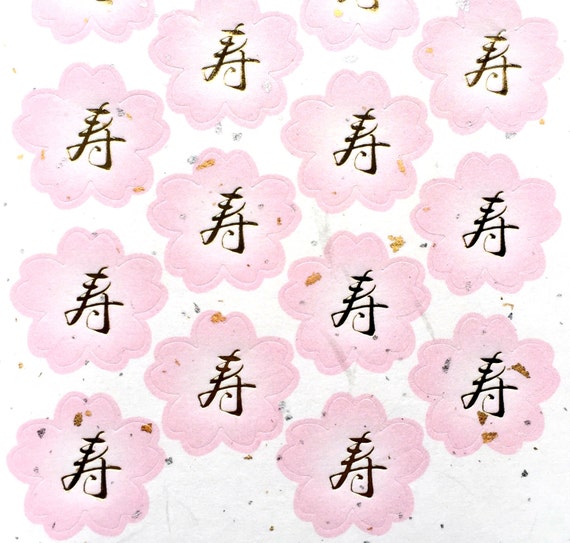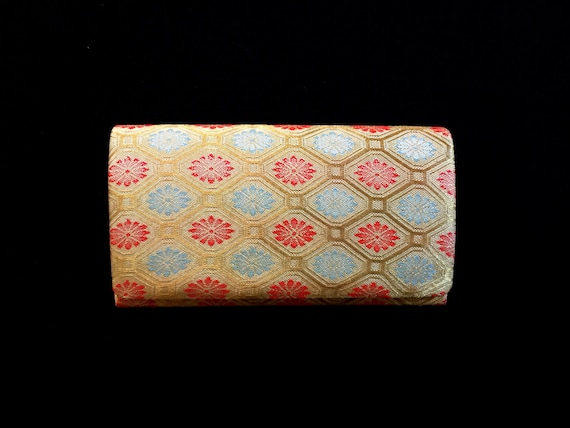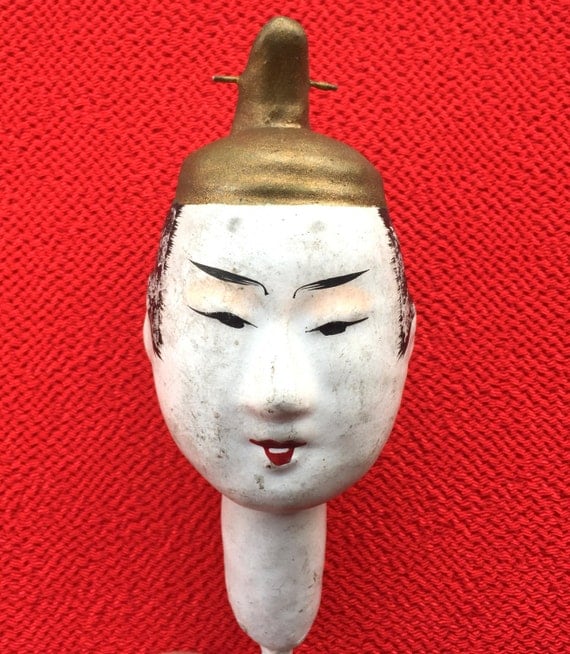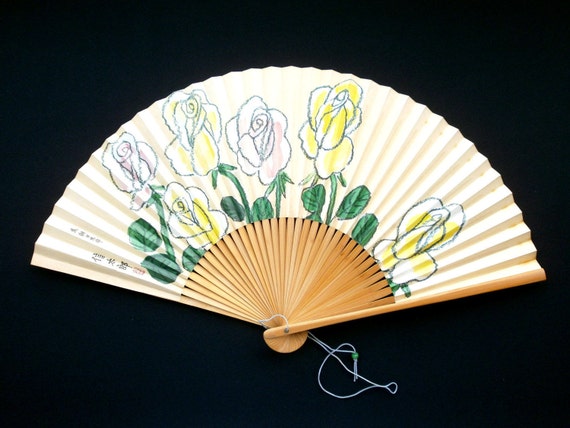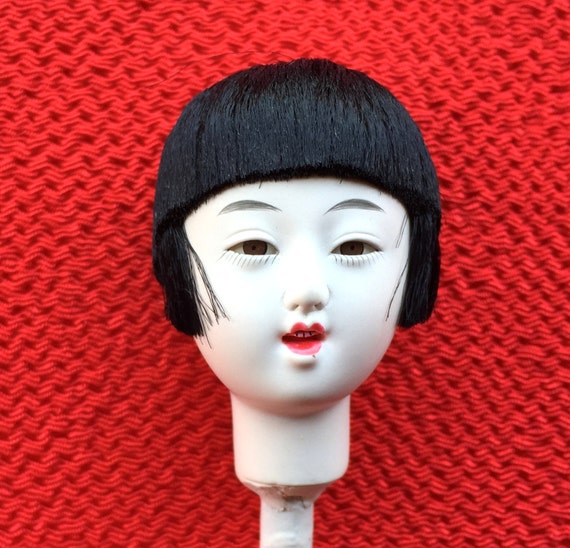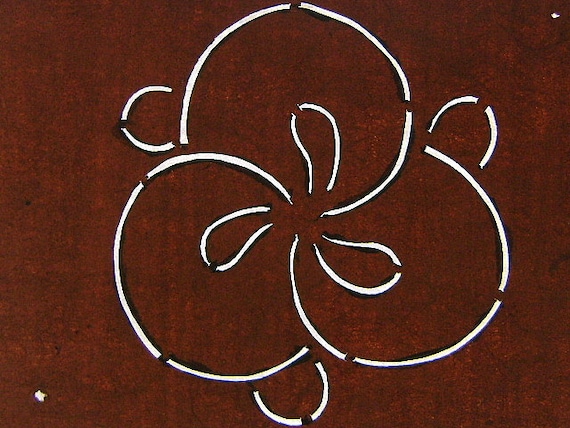 Vintage Japanese Stencil - Traditional Japanese Stencil - Family Crest - Flower
This was an amazing find. They are from the "昭和" "showa period" . The "showa" period is from 1926-1989 but these are at about 25-30 years old . This is called "型紙" or "katagami". This is a stencil that was used to make "kashigata" (for more information on "kashigata please see below).
This is really gorgeous! The shape is that of a "kamon" which means a family crest (which crest we don't know). There are no set rules in the design of a kamon. It most commonly consists of a roundel encircling a figure of plant, animal, man-made, natural or celestial objects, all abstracted to various degrees. Religious symbols, geometric shapes and kanji were commonly used as well. These symbols are often found in logos of stores (which help to identify what they sell), sushi restaurants, and on packages of food to lend an air of elegance. Senbei (Japanese crackers) and other traditional Japanese sweets may also use one.
The stencil measures about 7.8 x 6.5 cm.
More information on "kashigata" (the sweets made from the molds that were made using the stencils).
In the past, when a person died, it was expensive to give flowers or fresh food so, people made sweets (these are made from soy flour, rice flour and sugar) in the form of flowers, fish etc. These items were then placed on the "butsudan" (family shrine found in the house) for the dead person.
The sweets was also used for holiday celebrations, tea ceremony etc. These are for decoration only-they are never eaten.
To see more stencils please click here
http://www.etsy.com/shop/VintageFromJapan?section_id=6263764
**********************************************************
Our Etsy Stores:
For handmade & cute food rings, earrings, pendants and other jewelry / accessory http://souzoucreations.etsy.com
For wholesale prices on cabochons, clay canes and morehttp://decosweets.etsy.com
For Japanese vintage goods http://vintagefromjapan.etsy.com
For Japanese stickers, fabric, and more http://fromjapanwithlove.etsy.com
Vintage Japanese Stencil - Traditional Japanese Stencil - Family Crest - Flower
This was an amazing find. They are from the "昭和" "showa period" . The "showa" period is from 1926-1989 but these are at about 25-30 years old . This is called "型紙" or "katagami". This is a stencil that was used to make "kashigata" (for more information on "kashigata please see below).
This is really gorgeous! The shape is that of a "kamon" which means a family crest (which crest we don't know). There are no set rules in the design of a kamon. It most commonly consists of a roundel encircling a figure of plant, animal, man-made, natural or celestial objects, all abstracted to various degrees. Religious symbols, geometric shapes and kanji were commonly used as well. These symbols are often found in logos of stores (which help to identify what they sell), sushi restaurants, and on packages of food to lend an air of elegance. Senbei (Japanese crackers) and other traditional Japanese sweets may also use one.
The stencil measures about 7.8 x 6.5 cm.
More information on "kashigata" (the sweets made from the molds that were made using the stencils).
In the past, when a person died, it was expensive to give flowers or fresh food so, people made sweets (these are made from soy flour, rice flour and sugar) in the form of flowers, fish etc. These items were then placed on the "butsudan" (family shrine found in the house) for the dead person.
The sweets was also used for holiday celebrations, tea ceremony etc. These are for decoration only-they are never eaten.
To see more stencils please click here
http://www.etsy.com/shop/VintageFromJapan?section_id=6263764
**********************************************************
Our Etsy Stores:
For handmade & cute food rings, earrings, pendants and other jewelry / accessory http://souzoucreations.etsy.com
For wholesale prices on cabochons, clay canes and morehttp://decosweets.etsy.com
For Japanese vintage goods http://vintagefromjapan.etsy.com
For Japanese stickers, fabric, and more http://fromjapanwithlove.etsy.com
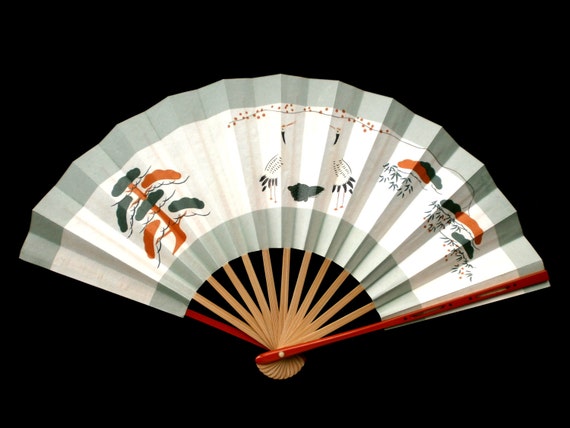 Hand Fan Ogi Sensu Hand Painted Small Size F77 Crane Turtle Pine Tree Japanese Lucky Symbols
This hand fan is called "Ogi" or "Sensu". There is image of Japanese lucky symbols (crane, turtle, pine tree, bamboo leaf and plum blossoms). The colors of hand fan are light blue, green, orange, black, white and cream. The wood is bamboo.
On the back, 5 pieces of silver leaf is pasted. There are 3 cute humans, green grasses, traditional building, green and orange leaves.
Crane and Turtle - symbols of long life.
Pine, Bamboo and Plum Blossom - Together they symbolize steadfastness, perseverance, and resilience.
It is hand painted and so beautiful!!.
This hand fan is simple yet elegant! This is vintage and while it is in great condition it isn't perfect.
It is about 20 cm long and when opened is about 34.5 cm wide.
**********************************************************
Our Etsy Stores:
Supplies and more FromJapanWithLove.etsy.com
Vintage VintageFromJapan.etsy.com
We will combine shipping if you buy from any of our stores.
Hand Fan Ogi Sensu Hand Painted Small Size F77 Crane Turtle Pine Tree Japanese Lucky Symbols
This hand fan is called "Ogi" or "Sensu". There is image of Japanese lucky symbols (crane, turtle, pine tree, bamboo leaf and plum blossoms). The colors of hand fan are light blue, green, orange, black, white and cream. The wood is bamboo.
On the back, 5 pieces of silver leaf is pasted. There are 3 cute humans, green grasses, traditional building, green and orange leaves.
Crane and Turtle - symbols of long life.
Pine, Bamboo and Plum Blossom - Together they symbolize steadfastness, perseverance, and resilience.
It is hand painted and so beautiful!!.
This hand fan is simple yet elegant! This is vintage and while it is in great condition it isn't perfect.
It is about 20 cm long and when opened is about 34.5 cm wide.
**********************************************************
Our Etsy Stores:
Supplies and more FromJapanWithLove.etsy.com
Vintage VintageFromJapan.etsy.com
We will combine shipping if you buy from any of our stores.
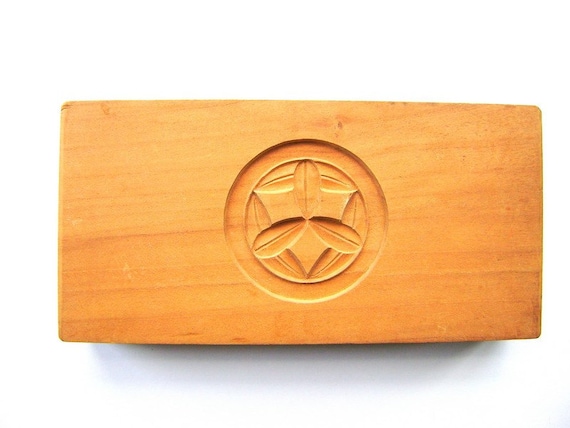 Vintage Kashigata - Japanese Cake Mold - Wood Mold - Wood Cake Mold - Vintage Mold - Kamon - Family Crest - bamboo leaf - caltrap
This is a vintage mold called "kashigata".
Often made of sakura (cherry wood) and seasoned for about 3 years before carving, kashigata were used to make dried confectionery made of rice flour and sugar called rakugan. Earliest records show that this practice dates back to the mid-17th century. These confections were used as offerings and snacks for celebratory occasions and even unfortunate events. For example when a person died, it was expensive to give flowers or fresh food so, people made these sweets in the form of flowers, fish etc. These items were then placed on the "butsudan" (family shrine found in the house) for the dead person.
Kashigata were also used in the making of wagashi (nama-gashi or freshly made cake and hi-gashi or dried confectionery) for tea ceremonies.
Common kashigata motifs in the Edo era - chrysanthemums, plum blossoms
Meiji Era - spread of western technology - balloons, planes
World War II - national pride heightened - cherry blossoms, battleships - used as gifts for departing troops, ceremonies and commemorative occasions
With the advent of refrigeration, fresh fish replaced rakugan motifs like the sea bream. Sadly today, making offerings for fortunate and unfortunate events is no longer a common practice. This in turn has lessened rakugan demand although they are still found in tea ceremonies and homes. The decrease in kashigata artisans today has made kashigata carving a dying craft making kashigata itself a sought-after collectible.
The shape is that of a "kamon" which means a family crest (which crest we don't know). There are no set rules in the design of a kamon. It most commonly consists of a roundel encircling a figure of plant, animal, man-made, natural or celestial objects, all abstracted to various degrees. Religious symbols, geometric shapes and kanji were commonly used as well. These symbols are often found in logos of stores (which help to identify what they sell), sushi restaurants, and on packages of food to lend an air of elegance. Senbei (Japanese crackers) and other traditional Japanese sweets may also use one.
*You can use this mold as food mold to cook. Please clean thoroughly before using.
It measures about 15.3 cm long x 7.6 cm wide x 2.4 cm tall. Inside it measures 5 cm x 5 cm .
**********************************************************
Our Etsy Stores:
Supplies FromJapanWithLove.etsy.com
Deco Sweet Supplies DecoSweets.etsy.com
Food Rings SouZouCreations.etsy.com
Vintage VintageFromJapan.etsy.com
Vintage Kashigata - Japanese Cake Mold - Wood Mold - Wood Cake Mold - Vintage Mold - Kamon - Family Crest - bamboo leaf - caltrap
This is a vintage mold called "kashigata".
Often made of sakura (cherry wood) and seasoned for about 3 years before carving, kashigata were used to make dried confectionery made of rice flour and sugar called rakugan. Earliest records show that this practice dates back to the mid-17th century. These confections were used as offerings and snacks for celebratory occasions and even unfortunate events. For example when a person died, it was expensive to give flowers or fresh food so, people made these sweets in the form of flowers, fish etc. These items were then placed on the "butsudan" (family shrine found in the house) for the dead person.
Kashigata were also used in the making of wagashi (nama-gashi or freshly made cake and hi-gashi or dried confectionery) for tea ceremonies.
Common kashigata motifs in the Edo era - chrysanthemums, plum blossoms
Meiji Era - spread of western technology - balloons, planes
World War II - national pride heightened - cherry blossoms, battleships - used as gifts for departing troops, ceremonies and commemorative occasions
With the advent of refrigeration, fresh fish replaced rakugan motifs like the sea bream. Sadly today, making offerings for fortunate and unfortunate events is no longer a common practice. This in turn has lessened rakugan demand although they are still found in tea ceremonies and homes. The decrease in kashigata artisans today has made kashigata carving a dying craft making kashigata itself a sought-after collectible.
The shape is that of a "kamon" which means a family crest (which crest we don't know). There are no set rules in the design of a kamon. It most commonly consists of a roundel encircling a figure of plant, animal, man-made, natural or celestial objects, all abstracted to various degrees. Religious symbols, geometric shapes and kanji were commonly used as well. These symbols are often found in logos of stores (which help to identify what they sell), sushi restaurants, and on packages of food to lend an air of elegance. Senbei (Japanese crackers) and other traditional Japanese sweets may also use one.
*You can use this mold as food mold to cook. Please clean thoroughly before using.
It measures about 15.3 cm long x 7.6 cm wide x 2.4 cm tall. Inside it measures 5 cm x 5 cm .
**********************************************************
Our Etsy Stores:
Supplies FromJapanWithLove.etsy.com
Deco Sweet Supplies DecoSweets.etsy.com
Food Rings SouZouCreations.etsy.com
Vintage VintageFromJapan.etsy.com
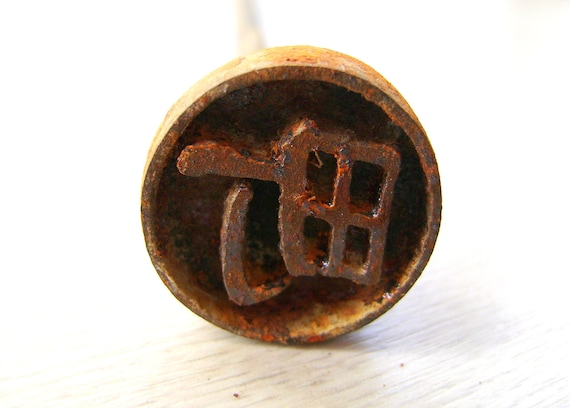 Vintage Branding Iron - Japanese Branding Iron - Yakin - Yakiin - Kanji Stamp - Metal Stamp - Chinese Character Stamp Town S56
This is a vintage branding iron called a "yakiin". These were/are used on wood, leather...food...anything you want to brand. Please see the last picture to see an example of how it can be used.
I think they would look fabulous if used in pottery as a stamp. Also...I think they could be used with ink but as it is metal, the image wouldn't be as smooth and clear as a rubber stamp -please keep that in mind if that is how you want to use it.
This is "machi" (in Kanji character) which means "town".
They are from the "昭和" "showa period" . The "showa" period is from 1926-1989 but these are at least 30 years old.
This is made of iron. Please look at the pictures carefully
It measures 22 cm long x 2.5 cm (the stamp) wide.
**********************************************************
Our Etsy Stores:
Supplies FromJapanWithLove.etsy.com
Deco Sweet Supplies DecoSweets.etsy.com
Food Rings SouZouCreations.etsy.com
Vintage VintageFromJapan.etsy.com
We will combine shipping if you buy from any of our stores.
Vintage Branding Iron - Japanese Branding Iron - Yakin - Yakiin - Kanji Stamp - Metal Stamp - Chinese Character Stamp Town S56
This is a vintage branding iron called a "yakiin". These were/are used on wood, leather...food...anything you want to brand. Please see the last picture to see an example of how it can be used.
I think they would look fabulous if used in pottery as a stamp. Also...I think they could be used with ink but as it is metal, the image wouldn't be as smooth and clear as a rubber stamp -please keep that in mind if that is how you want to use it.
This is "machi" (in Kanji character) which means "town".
They are from the "昭和" "showa period" . The "showa" period is from 1926-1989 but these are at least 30 years old.
This is made of iron. Please look at the pictures carefully
It measures 22 cm long x 2.5 cm (the stamp) wide.
**********************************************************
Our Etsy Stores:
Supplies FromJapanWithLove.etsy.com
Deco Sweet Supplies DecoSweets.etsy.com
Food Rings SouZouCreations.etsy.com
Vintage VintageFromJapan.etsy.com
We will combine shipping if you buy from any of our stores.
 Vintage Japanese Typewriter Key - Metal Stamp - Kanji Stamp - Chinese Character - Vintage Typewriter - Box Case Correspondence
We were lucky to come across a case of these "katsuji" (Japanese typewriter "keys"). There are over 2300 of these. They are vintage but have never been used. These would have been the extras in case the ones in the machine broke. Please look at the last picture to see what an old Japanese typewriter looked like. There were at least 2000 keys so needless to say, this was only used in businesses.
They are from the "昭和" "showa period" . The "showa" period is from 1926-1989 but these are at least 30 years old as Japanese stopped using them once the word processor was invented.
This would be perfect for using as a stamp with ink or for stamping clay etc.
This stamp is the Kanji (Chinese character) for "函" "hako" = "box, case, correspondence".
It measures 2.3 cm long (long enough to be able to get a nice grip) and 5mm wide. The Chinese character itself is about 5mm wide....so please note how tiny it is. It is made of metal.
**********************************************************
Our Etsy Stores:
Supplies- FromJapanWithLove.etsy.com
Deco Sweet Supplies- DecoSweets.etsy.com
Handmade- SouZouCreations.etsy.com
Vintage- VintageFromJapan.etsy.com
We will combine shipping if you buy from any of our stores.
Vintage Japanese Typewriter Key - Metal Stamp - Kanji Stamp - Chinese Character - Vintage Typewriter - Box Case Correspondence
We were lucky to come across a case of these "katsuji" (Japanese typewriter "keys"). There are over 2300 of these. They are vintage but have never been used. These would have been the extras in case the ones in the machine broke. Please look at the last picture to see what an old Japanese typewriter looked like. There were at least 2000 keys so needless to say, this was only used in businesses.
They are from the "昭和" "showa period" . The "showa" period is from 1926-1989 but these are at least 30 years old as Japanese stopped using them once the word processor was invented.
This would be perfect for using as a stamp with ink or for stamping clay etc.
This stamp is the Kanji (Chinese character) for "函" "hako" = "box, case, correspondence".
It measures 2.3 cm long (long enough to be able to get a nice grip) and 5mm wide. The Chinese character itself is about 5mm wide....so please note how tiny it is. It is made of metal.
**********************************************************
Our Etsy Stores:
Supplies- FromJapanWithLove.etsy.com
Deco Sweet Supplies- DecoSweets.etsy.com
Handmade- SouZouCreations.etsy.com
Vintage- VintageFromJapan.etsy.com
We will combine shipping if you buy from any of our stores.

 Japanese Hand Towel Tenugui 100% Cotton Japanese Fairy Tales White And Red
http://www.ebay.com/itm/Japanese-Hand-Towel-Tenugui-100-Cotton-Japanese-Fairy-Tales-White-And-Red-/131866965964
This hand towel is called a "tenugui". A Tenugui (手拭い) is a thin Japanese hand towel made of cotton. It is typically plain woven and is almost always dyed with some pattern. It can be used for anything a towel could be used for - as a washcloth, dishcloth, but often as a headband, souvenir or decoration. Towels made from terry cloth have replaced many of its use in the household. However tenugui are still popular as souvenirs, decorations, and as a head covering in kendo, where it functions as a sweatband, as extra padding beneath the headgear (men), and to identify the participants by team color.
Japanese Hand Towel Tenugui 100% Cotton Japanese Fairy Tales White And Red
http://www.ebay.com/itm/Japanese-Hand-Towel-Tenugui-100-Cotton-Japanese-Fairy-Tales-White-And-Red-/131866965964
This hand towel is called a "tenugui". A Tenugui (手拭い) is a thin Japanese hand towel made of cotton. It is typically plain woven and is almost always dyed with some pattern. It can be used for anything a towel could be used for - as a washcloth, dishcloth, but often as a headband, souvenir or decoration. Towels made from terry cloth have replaced many of its use in the household. However tenugui are still popular as souvenirs, decorations, and as a head covering in kendo, where it functions as a sweatband, as extra padding beneath the headgear (men), and to identify the participants by team color.
This is all about Japanese fairy tales.
For example there is "momo taro" or peach boy.
According to the present form of the tale (dating to the Edo period), Momotarō came to Earth inside a giant peach, which was found floating down a river by an old, childless woman who was washing clothes there. The woman and her husband discovered the child when they tried to open the peach to eat it. The child explained that he had been sent by Heaven to be their son. The couple named him Momotarō, from momo (peach) and tarō (eldest son in the family).
Years later, Momotarō left his parents to fight a band of marauding oni (demons or ogres) on a distant island. En route, Momotarō met and befriended a talking dog, monkey, and pheasant, who agreed to help him in his quest. At the island, Momotarō and his animal friends penetrated the demons' fort and beat the band of demons into surrendering. Momotarō and his new friends returned home with the demons' plundered treasure and the demon chief as a captive. Momotarō and his family lived comfortably from then on.
Momotarō is strongly associated with Okayama, and his tale may have its origins there. The demon island (Onigashima (鬼ヶ島)) of the story is sometimes associated with Megijima Island, an island in the Seto Inland Sea near Takamatsu, due to the vast manmade caves found on that island.
Also there is Princess Kaguya-tale of the bamboo cutter. One day, while walking in the bamboo forest, an old, childless bamboo cutter called Taketori no Okina (竹取翁 "the Old Man who Harvests Bamboo") came across a mysterious, shining stalk of bamboo. After cutting it open, he found inside it an infant the size of his thumb. He rejoiced to find such a beautiful girl and took her home. He and his wife raised her as their own child and named her Kaguya-hime (かぐや姫 accurately, Nayotake-no-Kaguya-hime "princess of flexible bamboos scattering light"). Thereafter, Taketori no Okina found that whenever he cut down a stalk of bamboo, inside would be a small nugget of gold. Soon he became rich. Kaguya-hime grew from a small baby into a woman of ordinary size and extraordinary beauty. At first, Taketori no Okina tried to keep her away from outsiders, but over time the news of her beauty spread.
Eventually, five princes came to Taketori no Okina's residence to ask for Kaguya-hime's hand in marriage. The princes eventually persuaded Taketori no Okina to tell a reluctant Kaguya-hime to choose from among them. Kaguya-hime concocted impossible tasks for the princes, agreeing to marry the one who managed to bring her his specified item. That night, Taketori no Okina told the five princes what each must bring. The first was told to bring her the stone begging bowl of the Buddha from India, the second a jeweled branch from the mythical island of Hōrai, the third the legendary robe of the fire-rat of China, the fourth a colored jewel from a dragon's neck, and the final prince a cowry shell born of swallows.
Realizing that it was an impossible task, the first prince returned with an expensive bowl, but after noticing that the bowl did not glow with holy light, Kaguya-hime saw through his deception. Likewise, two other princes attempted to deceive her with fakes, but also failed. The fourth gave up after encountering a storm, while the final prince lost his life (severely injured in some versions) in his attempt.
After this, the Emperor of Japan, Mikado, came to see the strangely beautiful Kaguya-hime and, upon falling in love, asked her to marry him. Although he was not subjected to the impossible trials that had thwarted the princes, Kaguya-hime rejected his request for marriage as well, telling him that she was not of his country and thus could not go to the palace with him. She stayed in contact with the Emperor, but continued to rebuff his requests and marriage proposals.
That summer, whenever Kaguya-hime saw the full moon, her eyes filled with tears. Though her adoptive parents worried greatly and questioned her, she was unable to tell them what was wrong. Her behaviour became increasingly erratic until she revealed that she was not of this world and must return to her people on the Moon. In some versions of this tale, it is said that she was sent to the Earth, where she would inevitably form material attachment, as a temporary punishment for some crime, while in others, she was sent to Earth for her own safety during a celestial war. The gold that Taketori no Okina had been finding had in fact been a stipend from the people of the Moon, sent down to pay for Kaguya-hime's upkeep.
As the day of her return approached, the Emperor sent many guards around her house to protect her from the Moon people, but when an embassy of "Heavenly Beings" arrived at the door of Taketori no Okina's house, the guards were blinded by a strange light. Kaguya-hime announced that, though she loved her many friends on Earth, she must return with the Moon people to her true home. She wrote sad notes of apology to her parents and to the Emperor, then gave her parents her own robe as a memento. She then took a small taste of the elixir of life, attached it to her letter to the Emperor, and gave it to a guard officer. As she handed it to him, the feather robe was placed on her shoulders, and all of her sadness and compassion for the people of the Earth were forgotten. The heavenly entourage took Kaguya-hime back to Tsuki-no-Miyako (月の都/京; lit. "the Capital of the Moon"), leaving her earthly foster parents in tears.
The parents became very sad and were soon put to bed sick. The officer returned to the Emperor with the items Kaguya-hime had given him as her last mortal act, and reported what had happened. The Emperor read her letter and was overcome with sadness. He asked his servants, "Which mountain is the closest place to Heaven?", to which one replied the Great Mountain of Suruga Province. The Emperor ordered his men to take the letter to the summit of the mountain and burn it, in the hope that his message would reach the distant princess. The men were also commanded to burn the elixir of immortality since the Emperor did not wish to live forever without being able to see her. The legend has it that the word immortality (不死 fushi, or fuji) became the name of the mountain, Mount Fuji. It is also said that the kanji for the mountain, 富士山 (literally "Mountain Abounding with Warriors"), are derived from the Emperor's army ascending the slopes of the mountain to carry out his order. It is said that the smoke from the burning still rises to this day. (In the past, Mount Fuji was much more volcanically active.)
It is 35 cm x 87 cm and is 100% cotton.
 Japanese Doll Head - Girl Doll Head - Body Part - Hina Matsuri - Japanese Doll Festival - D8-45
This is a doll head meant to be used for "Hina Matsuri" or Japanese doll festival. The details are really amazing! This doll head is made from clay.
About Hina Matsuri
Platforms with a red hi-mōsen are used to display a set of ornamental dolls (雛人形, hina-ningyō?) representing the Emperor, Empress, attendants, and musicians in traditional court dress of the Heian period. The custom of displaying dolls began during the Heian period. Formerly, people believed the dolls possessed the power to contain bad spirits.
This one measures about 23 cm long including her hair and about 11 cm including the stick and about 14.5 cm around.
**********************************************************
Our Etsy Stores:
Japanese Style Craft Supplies FromJapanWithLove.etsy.com
Vintage From Japan VintageFromJapan.etsy.com
We will combine shipping if you buy from any of our stores.
Japanese Doll Head - Girl Doll Head - Body Part - Hina Matsuri - Japanese Doll Festival - D8-45
This is a doll head meant to be used for "Hina Matsuri" or Japanese doll festival. The details are really amazing! This doll head is made from clay.
About Hina Matsuri
Platforms with a red hi-mōsen are used to display a set of ornamental dolls (雛人形, hina-ningyō?) representing the Emperor, Empress, attendants, and musicians in traditional court dress of the Heian period. The custom of displaying dolls began during the Heian period. Formerly, people believed the dolls possessed the power to contain bad spirits.
This one measures about 23 cm long including her hair and about 11 cm including the stick and about 14.5 cm around.
**********************************************************
Our Etsy Stores:
Japanese Style Craft Supplies FromJapanWithLove.etsy.com
Vintage From Japan VintageFromJapan.etsy.com
We will combine shipping if you buy from any of our stores.
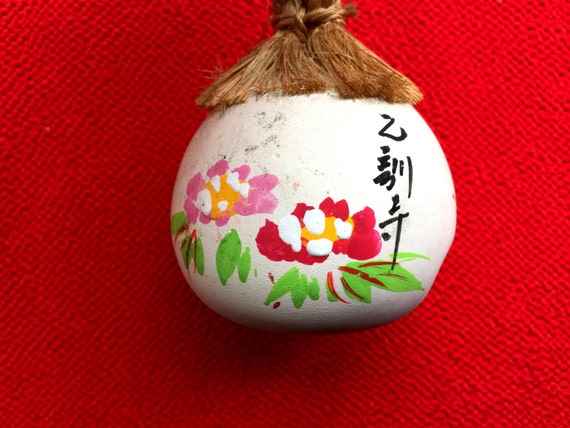 Japanese Ceramic Bell - Amulet - Lucky Charm - The Peony of Otokuni-dera Temple - Vintage Bell - Migawari Omamori (B1-25)
This is a ceramic bell called 土鈴 "dorei". 鈴 is "Suzu" which means bell and 土 is "do" which means earth, soil and is part of 粘土 meaning clay. So...this is a clay/ceramic bell. These bells have a ceramic ball inside so the sound is a coarse, rolling sound.
Bells of all kinds, have a long history in Japan. Dorei (ceramic bells) date back to the prehistoric Jomon Era (10,000 B.C.-300 B.C.). These bells were used to scare away evil. At Shinto shrines, large bells drape over entrances, as it is said that ringing them calls gets the attention of the Gods allowing one to acquire positive power and authority, while repelling evil.
This is a "migawari suzu" which is a type of "omamori". Omamori are amulets - they are physical objects that contain the spiritual essence and powers of a deity or buddha . " Migawari omamori" (身代わりお守り,means that the item takes the place of the person...so the bad luck is transferred, in this case, to the bell.
For a fabulous and interesting read on omamori please see http://www.tofugu.com/2014/06/25/omamori-protecting-yourself-in-little-ways/
This bell is from Otokuni-dera (乙訓寺) - a temple of a peony, and it is considered as beginning that two stocks of buttons were contributed from Chokoku-ji which is head temple. About 2,000 stocks of flowers will make a large flower bloom from the end of April early in May.
http://penjpn.com/20kyoto/otokunidera.html
参拝記念 Sanpai Kinen = Worship Memorial
This bell is about 11.5 cm high (including rope loop) and about 6 cm wide.
This will be will padded and shipped in a box.
Japanese Ceramic Bell - Amulet - Lucky Charm - The Peony of Otokuni-dera Temple - Vintage Bell - Migawari Omamori (B1-25)
This is a ceramic bell called 土鈴 "dorei". 鈴 is "Suzu" which means bell and 土 is "do" which means earth, soil and is part of 粘土 meaning clay. So...this is a clay/ceramic bell. These bells have a ceramic ball inside so the sound is a coarse, rolling sound.
Bells of all kinds, have a long history in Japan. Dorei (ceramic bells) date back to the prehistoric Jomon Era (10,000 B.C.-300 B.C.). These bells were used to scare away evil. At Shinto shrines, large bells drape over entrances, as it is said that ringing them calls gets the attention of the Gods allowing one to acquire positive power and authority, while repelling evil.
This is a "migawari suzu" which is a type of "omamori". Omamori are amulets - they are physical objects that contain the spiritual essence and powers of a deity or buddha . " Migawari omamori" (身代わりお守り,means that the item takes the place of the person...so the bad luck is transferred, in this case, to the bell.
For a fabulous and interesting read on omamori please see http://www.tofugu.com/2014/06/25/omamori-protecting-yourself-in-little-ways/
This bell is from Otokuni-dera (乙訓寺) - a temple of a peony, and it is considered as beginning that two stocks of buttons were contributed from Chokoku-ji which is head temple. About 2,000 stocks of flowers will make a large flower bloom from the end of April early in May.
http://penjpn.com/20kyoto/otokunidera.html
参拝記念 Sanpai Kinen = Worship Memorial
This bell is about 11.5 cm high (including rope loop) and about 6 cm wide.
This will be will padded and shipped in a box.






